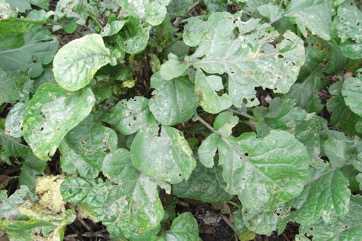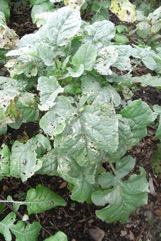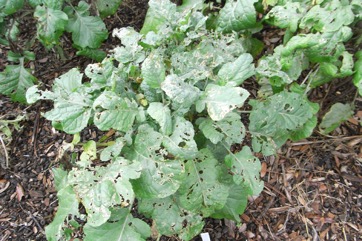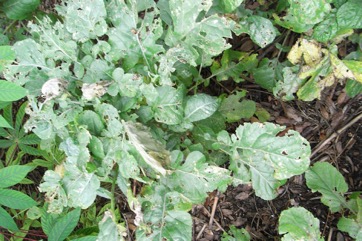Abyssinian cabbage, African cabbage

A tropical plant. It occurs in the highlands of Ethiopia and Kenya. It has been introduced to other countries. It will grow on most agricultural soils. It needs a cool climate (15-20°C) and requires a sunny position. It is mostly grown between 1500-2500 m altitude in tropical regions. It can grow with a rainfall of 200-500 mm but is usually sown at the beginning of the rains.
Also known as:
Abyssinian mustard, Chembere dzagumana, Ethiopian mustard, Karate, Senafich, Tsunga, Yabesha gomen
Synonyms
- Brassica integrifolia (West) Rupr. sensu Jons.
- Brassica integrifolia (West) Schulz. var. carinata (A. Braun) O. Schultz.
- Brassica juncea (L.) Coss.
- Sinapsis integrifolia West.
- Sinapsis abyssinica A. Br.
Edible Portion
- Leaves, Seeds, Flower buds, Vegetable
Where does Abyssinian cabbage grow?
Found in: Africa, Asia, Botswana, Cameroon, Central Africa, Congo DR, Côte d'Ivoire, East Africa, Eritrea, Ethiopia, Haiti, India, Ivory Coast, Kenya, Madagascar, Malawi, Mozambique, Southern Africa, South Sudan, Sudan, Tanzania, Uganda, West Africa, Zambia, Zimbabwe
Notes: There are about 30 Brassica species and many cultivated varieties. It is an amphidiploid between Brassica nigra and Brassica oleracea cultivated for 4,000 years.
Status: It is a commercially cultivated vegetable. It is common and important in the highlands of Ethiopia and Kenya. The leaves and seeds are sold in markets.
Growing Abyssinian cabbage, African cabbage
Cultivation: It is grown from seed. Seed germinate and come up in about 3 days. Leafy kinds do best on fertile well drained soils. For leafy kinds seed is sown into a fine well prepared seed bed and transplanted after 6 weeks. Plants can be established from cuttings. For leafy kinds a spacing of 50 x 50 cm is suitable. Oil seed kinds are sown more closely with about 500,000 plant per hectare.
Edible Uses: The seeds are cooked whole. They are used to make a mustard. The young leaves are cooked. They are also used in salads. The flower buds and young shoots are eaten raw. The seed produces a good quality cooking oil. (It has a mustard taste unless refined)
Production: Leaf yields can be 4800 kg per hectare. Much higher yields are possible with intensive production. Leaf harvest can occur after 47 days under best conditions.
Nutrition Info
per 100g edible portion| Edible Part | Energy (kcal) | Protein (g) | Iron (mg) | Vitamin A (ug) | Vitamin c (mg) | Zinc (mg) | % Water |
|---|---|---|---|---|---|---|---|
| Leaves | - | 3.5 | 1.3 | - | 157 | 0.9 | 88 |
| Seeds | - | - | - | - | - | - | |
| Flower buds | - | - | - | - | - | - |
Abyssinian cabbage, African cabbage Photos




References
Abukutsa-Onyango, Mary, 2007, The diversity of cultivated African leafy vegetables in three communities in western Kenya. AJFAND, Volume 7, No. 3
Addis, G., et al, 2005, Ethnobotanical Study of Edible Wild Plants in Some Selected Districts of Ethiopia. Human Ecology, Vol. 33, No. 1, pp. 83-118
AVRDC files
Bircher, A. G. & Bircher, W. H., 2000, Encyclopedia of Fruit Trees and Edible Flowering Plants in Egypt and the Subtropics. AUC Press. p 64
Ethiopia: Famine Food Field Guide. http://www.africa.upenn.edu/faminefood/category3.htm
Facciola, S., 1998, Cornucopia 2: a Source Book of Edible Plants. Kampong Publications, p 52
FAO, 1988, Traditional Food Plants, FAO Food and Nutrition Paper 42. FAO Rome p 117
Flora 24:267. 1841
Grubben, G. J. H. and Denton, O. A. (eds), 2004, Plant Resources of Tropical Africa 2. Vegetables. PROTA, Wageningen, Netherlands. p 119
Hedrick, U.P., 1919, (Ed.), Sturtevant's edible plants of the world. p 120
Hemingway, J.S., 1979, Mustards, in Simmonds N.W.,(ed), Crop Plant Evolution. Longmans. London. p 56
Jardin, C., 1970, List of Foods Used In Africa, FAO Nutrition Information Document Series No 2.p 40, 60 (As Brassica integrifolia var. carinata)
Kays, S. J., and Dias, J. C. S., 1995, Common Names of Commercially Cultivated Vegetables of the World in 15 languages. Economic Botany, Vol. 49, No. 2, pp. 115-152
Latham, P., 2004, Useful Plants of Bas-Congo province. Latham & DFID p 54
Latham, P. & Mbuta, A. K., 2014, Useful Plants of Bas-Congo Province, Democratic Republic of Congo. Volume 1. Salvation Army. p 82
Maundu, P. et al, 1999, Traditional Food Plants of Kenya. National Museum of Kenya. p 79
Molla, A., Ethiopian Plant Names. http://www.ethiopic.com/aplants.htm
Oomen, H.A.P.C., & Grubben, G.J.H., 1978, Tropical Leaf Vegetables in Human Nutrition, Communication 69, Department of Agricultural research, RTI Amsterdam, p 66, 70, 78
Pham-Hoang Ho, 1999, An Illustrated Flora of Vietnam. Nha Xuat Ban Tre. p 603 ? (As Brassica integrifolia var. carinata)
Plants for a Future database, The Field, Penpol, Lostwithiel, Cornwall, PL22 0NG, UK. http://www.scs.leeds.ac.uk/pfaf/
Ruiters-Welcome, A. K., 2019, Food plants of southern Africa. Ph.D. thesis. Univ. of Johannesburg p 39
Seidemann J., 2005, World Spice Plants. Economic Usage, Botany, Taxonomy. Springer. p 69
Shava, S., et al, 2009, Traditional food crops as a source of community resilience in Zimbabwe. International Journal of the African Renaissance 4(1)
Weinberger, K., Msuya J., 2004, Indigenous Vegetables in Tanzania. Significance and Prospects. Technical Bulletin No. 31 AVRDC, Taiwan/FAO p 4
USDA, ARS, National Genetic Resources Program. Germplasm Resources Information Network - (GRIN). [Online Database] National Germplasm Resources Laboratory, Beltsville, Maryland. Available: www.ars-grin.gov/cgi-bin/npgs/html/econ.pl (10 April 2000)
van Wyk, B., 2005, Food Plants of the World. An illustrated guide. Timber press. p 98
Wikipedia
World Checklist of Useful Plant Species 2020. Royal Botanic Gardens, Kew